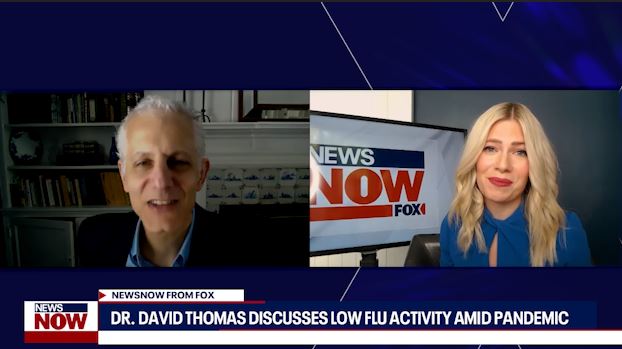Doctors say flu activity remains ‘surprisingly low’ amid COVID-19 pandemic
LOS ANGELES - As 2020’s fall and winter seasons approached, health officials worried that the United States would be simultaneously fighting and dealing with the impacts of the COVID-19 pandemic and flu season, but that has not been the case, according to experts.
Some coined the feared coalescence of coronavirus and influenza as a "twindemic."
"We were very worried about that," Dr. David Thomas, a professor of medicine at Johns Hopkins University, told FOX Television Stations. "One of the reasons we were worried about it is just because of the capacity to take care of people."
Every winter there is a surge in hospitalizations due to respiratory illnesses, including influenza, so health officials brace yearly for an increase in hospital visits.
RELATED: Flu vs. common cold vs. COVID-19: Similar symptoms, many questions
But health officials and researchers were baffled when they learned that seasonal influenza activity in the United States was drastically low and remains lower than usual for this time of year.
According to the U.S. Centers for Disease Control and Prevention, the percentage of respiratory specimens testing positive for influenza at clinical laboratories was only 0.1% during the week ending Feb. 6.
Meanwhile, only 1.1% of patients visited health care providers for the flu during the same timeframe, and all jurisdictions in the United States experienced minimal activity.
In fact, only 0.2% tested positive for influenza cumulatively since Sept. 27 — around when flu season typically begins.
FluSurv-NET reported 165 laboratory confirmed influenza hospitalizations between Oct. 1, 2020 and Feb. 6, 2021 for an overall hospitalization rate of just 0.6% per 100,000 population.
"This is lower than average for this point in the season and lower than rates for any season since routine data collection began in 2005, including the low severity 2011-12 season," the CDC wrote.
At this time last year, close to 100 times as many flu cases were identified from nearly the same number of tests. Flu activity maps were dotted with shades of red and orange — indicating heightened activity — but now the maps remain mainly green, marking low and minimal activity.
"It’s very reassuring during this recent surge in COVID that we were spared the double impact of COVID plus influenza," Thomas said.
Why are influenza cases significantly fewer than in years past?
"What we’re asking is what’s different this year?" Thomas said. "There’s a lot of factors that go into it, but of course this year, we think that it’s because of COVID."
"All the things that you do to protect yourself against COVID would also reduce the risk of getting influenza," Thomas explained. "So the obvious explanation is that there is less flu, because we are just being more careful."
Thomas said those "careful" precautions include COVID-19 recommendations issued by the CDC — mask wearing, hand washing and social distancing.
"Now we’re being more careful than ever because of COVID, and I think that’s dropping the influenza risk as well," Thomas said.
Thomas said influenza rates remain low all across the country, regardless of whether some states have more or less restrictive coronavirus mandates put into place.
While the pandemic has influenced the volume and manner by which flu cases are reported (i.e. a person may be less inclined to get checked for the flu during a pandemic), Thomas reiterates that it cannot be the only reason.
"Overall, it’s such a dramatic difference, and the one thing we know is different this year than other years is COVID," Thomas said. "COVID gets the credit or the blame depending on how you look at it."
RELATED: Flu rates down nationwide
School closures also likely played a role, as early research suggests kids transmit the influenza virus better than they do COVID-19, Dr. Abisola Olulade, a family medicine physician in California, explained to FOX News.
"Transmission of flu is harder than the transmission of coronavirus," Olulade said. "Mitigation measures were more limited in their ability to prevent people from getting COVID."
Reduced socializing could be keeping flu out of homes
The flu virus is known to spread more quickly in confined environments — especially when many individuals are indoors together.
But the flu may not be finding its way into as many homes this year because people aren’t socializing as much outside their own households, Thomas said.
"The difference is now we’re staying inside, but we’re staying inside with the same people for a couple weeks at a time," Thomas explained. "If no one goes out and gets it and brings it home, then being home is not a risk."
Various studies are currently being done to research the pandemic’s affect on the flu.
RELATED: Researchers to pay volunteers more than $3,000 to be deliberately infected with flu virus
For example, the Seattle Flu Study is continuing its research in the 2020-2021 flu season with a commitment to investigating the overlap of the COVID-19 pandemic, seasonal influenza, and the transmission of other respiratory illnesses.
According to The Atlantic, the research team has run 6,000 tests, and only two have come back positive.
Could flu activity increase post-COVID-19 pandemic?
While flu activity is currently low, Thomas said it could increase in the coming months, if we lessen the restrictions (staying at home, washing hands, etc.) that have seemingly contributed to low influenza rates.
Thomas still stressed the importance of getting an influenza vaccine despite the lower risk at this time.
"Influenza hasn’t gone away. It will for sure come back," Thomas said. "I am somewhat hopeful that things that we’ve learned societally will stick with us and that we’ll be safer in the future with all respiratory infections just by being a little more careful, knowing a little bit more about how these things are spread and washing our hands a bit more... I think all of those things will be lasting lessons that will help reduce the risk of all respiratory infections."
As of Feb. 18, there had been over 27.8 million cases of COVID-19 in the United States. The virus had also claimed more than 490,000 lives, according to data from Johns Hopkins University.



